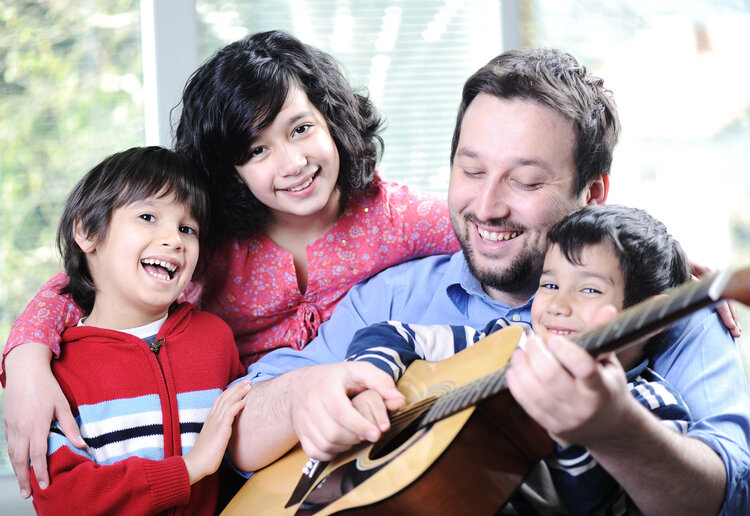
This is a challenging time for many as businesses and schools are closed to prevent the spread of the COVID-19 virus. Millions of children are having to stay home, and one of the biggest concerns for parents is what to do with their children once the at-home school assignments are done.
As a music therapist with 15 years of experience in the field, I have spent a lot of time helping families create and implement at-home music programs with a multitude of therapeutic goals. As fear and worry surround us during this shutdown, it is of utmost importance to also focus on optimum mental health. Multiple studies over the years have shown that music therapy can help reduce anxiety, depression, fear and worry. We need its benefits now more than ever.
Here are some musical activities you can enjoy with your family during this time. Make it fun, make it educational and make it meaningful and memorable! You want your children to remember that during stress and chaos, “My family came together through music and play.”
1. Music Improvisation or Family Jam Session
Most music therapists use music improvisation (or jamming) as a way of connection, communication and helping clients redirect their energy and focus. You do not need to be a musician to improvise music. You can use instruments you already have at home or use objects around your home such as pots and pans, buckets, keys and plastic containers. You can also create a fun scavenger hunt and challenge your family to see how many items they can find to turn into instruments. Enjoy the sounds and rhythms you can make together. Solos are also fun!

2. Play Lists
Music therapists often help clients collect songs and create playlists to match their emotions or create memories of monumental moments. You and your family can choose emotions and search for songs to place in each play list. Children can do this on their own if you give them directions and access to YouTube to find songs. Some category examples are:
- Music to motivate me
- Music that makes me happy
- Music from my favorite movie
- Music that calms me
- Family favorites
3. Dance Party
Music and movement help us regulate our emotions and allow us to release tension. When music is played, our whole bodies receive the therapeutic benefits of its vibration and sound. Music moves us to move and dance, so why not create a list of your family’s favorite dance songs and move together?
4. Karaoke
Singing decreases anxiety and depression and is a powerful tool in expressing our feelings. Find some family favorites and sing along together. YouTube has a lot of karaoke sing-along versions of songs that could be fun for you and your family.

5. Song Rewriting
Music therapists use song rewriting activities to help clients connect to their feelings or express themselves. Song rewriting can be made easier by taking out various words from a familiar song so your family can fill in the blanks to make the song their own.
6. Music for Relaxation and Mindfulness
Music can help us relax, practice mindfulness, focus on positivity and allow us to let go of negative or fearful thoughts. Go through all your family’s favorite songs and choose some that help everyone to feel calm. I prefer to use music that has no lyrics to help focus on images or thoughts that come to mind when you sit and listen.
7. Music and Art
Music and art are a powerful combination for helping us express, focus and share our thoughts and feelings, practice mindfulness and explore creativity. Have your children try painting, drawing or collaging to match music that is playing or their feelings.
8. Make Your Own Instruments
This has usually been a favorite in my sessions with children. Make this activity fun and encourage your children to find things around the house that they can use to make their own instruments. Empty pill bottles can turn into a musical shaker if filled with rice or beans. Plastic containers can turn into a guitar or stringed instrument with elastic bands strung around them. Pots and pans are always a favorite with young children – but not so much with parents!

9. Music Trivia
This will take a little research, but can be a fun way to learn more about music, lyrics and artists. Use the Internet to research musical topics and create a trivia game for your family. For example:
- How many songs can you list with the word “happy” in them?
- Name 3 songs by Beyonce.
- Who sang “Let it go”?
10. Learn a New Instrument
For those who have an instrument at home, this can be an ideal time to sit down and learn some of the basics of playing it. YouTube has many videos on basic piano, guitar and ukulele technique – to name a few. I highly recommend ukulele, as it is an affordable instrument that is easier to learn than guitar – especially for younger children.
Fender is currently offering new users a free three-month subscription to Fender Play, its online learning app for guitar, bass and ukulele. The platform uses instructor-guided videos to assist those embarking on their musical journey. From classics like Led Zeppelin to contemporary artists like Sia and Shawn Mendes, the Fender Play library allows users to pick their favorite genre and instrument of choice and start jamming.

11. Learning Through Music
How did most of us learn the alphabet? We sang it! Many music therapists use music to help children learn new material that they may be struggling with at school. Creating a simple melody can make math, reading, science and social studies lessons easier.
I hope you find these 11 musical activities helpful during this time of being homebound. Mewsic Moves is also offering music teletherapy sessions during this time. Learn more at mewsicmoves.com.
John Mews, MA, is a neurologic music therapist and founder of L.A.-based Mewsic Moves, an evidence-based creative-arts therapy method.
































